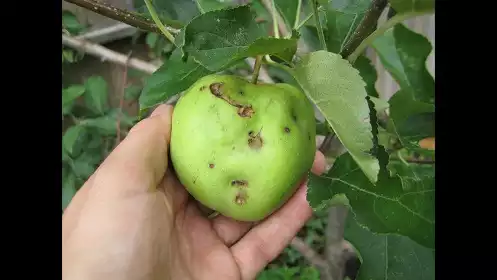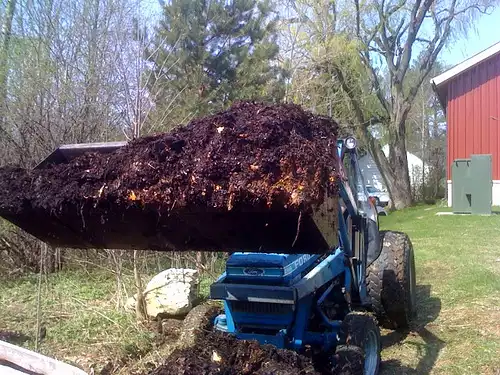Preventing Diseases in Fruit Trees
Imagine biting into a juicy, perfectly ripened piece of fruit, only to realize it sprang from your very own backyard!
Cultivating fruit trees can transform any garden into a lush, edible paradise.
However, this dream can quickly sour when diseases strike, turning vibrant leaves brown and spoiling the fruits of your labor—literally.
Preventing diseases in fruit trees is not just about salvaging this year’s harvest; it’s an art and science that ensures the longevity and vitality of your personal orchard for years to come.
Embark on an exciting journey with us as we delve into the world of fruit tree care—a realm where prevention is more than a cure; it’s a strategy to ensure your garden thrives in harmony with nature.
From understanding the early signs of infection to implementing innovative techniques that keep pathogens at bay, you’ll discover how safeguarding the health of your trees is akin to casting a protective spell over your garden.
Unveil the secrets behind preventing diseases in fruit trees and turn your green space into a resilient haven of delicious abundance.
Table of Contents Preventing Diseases in Fruit Trees
Proper pruning promotes tree health
Pruning plays a crucial role in maintaining the overall health and vitality of fruit trees.
By selectively removing damaged, diseased, or dead branches, proper pruning helps to improve air circulation and sunlight penetration within the tree canopy.
This, in turn, reduces the risk of fungal infections and promotes the growth of new, healthy branches.
Additionally, pruning helps to shape the tree’s structure, ensuring that it is balanced and able to support the weight of the fruit.
When done correctly and at the appropriate time, pruning can also stimulate the development of fruiting spurs, resulting in increased fruit production.
Therefore, implementing regular and proper pruning techniques is essential in preventing the occurrence of diseases and promoting the overall well-being of fruit trees.
Regularly inspect for pest infestations
To effectively protect fruit trees from potential pest infestations, it is imperative to regularly inspect them for any signs of trouble.
Vigilance is key.
Check for symptoms such as visible damage to the foliage, wilting leaves, distorted growth, or the presence of pests themselves, such as aphids, mites, or caterpillars.
Pay close attention to the undersides of leaves and the tree trunk, as pests often hide in these areas.
Timely identification of infestations allows for prompt action and the implementation of appropriate pest control measures.
By regularly inspecting fruit trees for pest infestations, you can mitigate the risk of damage to the trees, preserve their vitality, and ensure a healthy fruit crop.
Use organic methods for treatment
In the endeavor to prevent diseases in fruit trees, it is crucial to prioritize the use of organic methods for treatment.
Organic treatments offer a more sustainable approach that minimizes the potential harm to the environment and beneficial organisms.
These methods involve the use of natural products, such as neem oil, garlic spray, or beneficial insects like ladybugs, which can effectively control pests without introducing harmful chemicals into the ecosystem.
Additionally, organic treatments promote the long-term health and resilience of fruit trees, as they work in harmony with nature’s own defense mechanisms.
By adopting organic methods for treatment, fruit tree owners can ensure the well-being of their trees while maintaining a safe and toxin-free environment for themselves and their communities.
Avoid over-watering to prevent rot
To maintain the health of fruit trees and prevent the occurrence of rot, it is vital to exercise caution when it comes to watering.
Over-watering can create an excessively moist environment that is conducive to the growth of fungal pathogens, leading to rot and decay.
It is important to strike a balance by providing adequate moisture without drowning the roots.
One way to achieve this is to monitor the soil moisture levels regularly and only water when necessary.
This can be done by inserting a finger or a moisture meter into the soil to determine if watering is needed.
Additionally, it is advisable to water deeply but infrequently, allowing the soil to dry out slightly between watering sessions.
By avoiding over-watering and maintaining proper moisture levels, fruit tree owners can significantly reduce the risk of rot and promote the overall health of their trees.
Ensure proper soil drainage
Proper soil drainage is a critical component of preventing diseases in fruit trees.
When soil becomes compacted or lacks sufficient drainage, excess water can accumulate around the roots, leading to root rot and other fungal diseases.
To ensure proper soil drainage, it is recommended to assess the soil composition and make necessary amendments.
Incorporating organic matter such as compost or well-rotted manure can improve soil structure and promote better drainage.
Additionally, planting fruit trees in raised beds or mounds can help alleviate drainage issues by providing a higher level of elevation.
Regularly inspecting the drainage patterns in the orchard and addressing any standing water or areas of poor drainage can go a long way in safeguarding the health and productivity of fruit trees.
Clean pruning tools to prevent contamination
Maintaining clean pruning tools is another key aspect in preventing diseases in fruit trees.
Contamination from one tree to another can occur through the use of dirty or infected tools, allowing pathogens to spread and compromise the health of the entire orchard.
It is essential to regularly sanitize pruning tools to minimize the risk of disease transmission.
After each use, thoroughly clean the tools with a solution of bleach and water or a disinfectant specifically designed for pruning tools.
Make sure to remove any plant debris or sap from the blades, as these can harbor pathogens.
Additionally, consider sharpening the blades regularly to ensure clean and precise cuts, reducing the chances of creating entry points for infections.
By prioritizing cleanliness and proper maintenance of pruning tools, fruit tree growers can significantly reduce the risk of disease outbreaks and promote a healthier orchard environment.
Monitor and control fungal diseases
Regular monitoring and effective control measures are crucial in mitigating and managing fungal diseases in fruit trees.
Monitoring involves regularly inspecting trees for any signs of fungal infection, such as leaf spots, discoloration, wilting, or abnormal growth.
This can be done through visual observations and the use of diagnostic tools like handheld microscopes or plant disease detection kits.
Early detection is key, as it allows for prompt action to prevent the spread of the disease.
Once identified, appropriate control measures can be implemented, such as the application of fungicides or the removal and disposal of infected plant material.
It is important to choose fungicides that are specifically formulated for the targeted fungal pathogens and to follow application instructions and safety guidelines meticulously.
Integrated pest management techniques, such as promoting good orchard sanitation, ensuring proper airflow and sunlight penetration, and employing cultural practices like proper pruning and fertilization, can also aid in preventing and managing fungal diseases in fruit trees.
By diligently monitoring and implementing effective control strategies, fruit tree growers can safeguard their orchards and maintain healthy and productive trees.
Proper nutrition for strong trees
To ensure the optimal health and strength of fruit trees, proper nutrition is essential.
Providing trees with the necessary nutrients helps them develop strong root systems, robust branches, and vibrant foliage.
A well-balanced fertilizer, specifically formulated for fruit trees, should be applied at the appropriate times during the growing season.
This fertilizer should contain essential macro and micronutrients, including nitrogen, phosphorus, potassium, calcium, magnesium, and trace elements.
The application rates should be based on soil tests and the specific requirements of the fruit tree species.
Additionally, maintaining a consistent watering schedule and providing adequate irrigation is crucial for nutrient uptake and overall tree health.
Regularly monitoring nutrient levels and adjusting fertilization practices accordingly will contribute to the prevention of nutrient deficiencies and promote the growth of healthy, productive fruit trees.
In conclusion, proper prevention and management techniques can go a long way in keeping fruit trees healthy and productive.
By implementing practices such as proper pruning, regular inspections, and utilizing natural pest control methods, we can decrease the risk of diseases in our fruit trees.
It is also important to stay informed about any potential threats in your area and take necessary precautions to protect your trees.
With a little effort and attention, we can ensure the longevity and success of our fruit trees.
FAQ
What are some common diseases that affect fruit trees and how can they be prevented?
Some common diseases that affect fruit trees include apple scab, fire blight, powdery mildew, and brown rot.
To prevent these diseases, it is important to practice good orchard hygiene such as pruning infected branches, removing fallen leaves and fruit, and ensuring proper air circulation.
Regularly inspecting trees for signs of disease, applying fungicides or bactericides as necessary, and choosing disease-resistant varieties can also help prevent the spread of diseases in fruit trees.
Additionally, providing adequate nutrients, water, and sunlight can help trees build up their natural defenses against diseases.
What are some natural methods for preventing diseases in fruit trees, such as using beneficial insects or organic fungicides?
Natural methods for preventing diseases in fruit trees include introducing beneficial insects like ladybugs or lacewings to control pests, planting companion plants that repel harmful insects, using organic fungicides made from neem oil or copper sulfate, practicing good orchard hygiene by removing diseased plant parts, and maintaining proper spacing between trees to promote airflow and reduce humidity.
These methods help to prevent diseases without the need for synthetic chemicals, promoting a healthier ecosystem in the orchard.
How can proper pruning and maintenance practices help prevent diseases in fruit trees?
Proper pruning and maintenance practices help prevent diseases in fruit trees by promoting good air circulation, reducing areas for pathogens to thrive, and removing infected or dead branches.
Pruning also encourages healthy growth and strengthens the tree’s natural defenses against diseases, making it less susceptible to infections.
Regular maintenance such as removing debris, proper watering, and monitoring for early signs of disease can further prevent the spread of pathogens and ensure the overall health of the fruit tree.
By implementing these practices, fruit trees are better equipped to resist diseases and produce high-quality fruits.
What role does proper watering and fertilization play in preventing diseases in fruit trees?
Proper watering and fertilization are essential in preventing diseases in fruit trees as they help maintain overall tree health and resilience.
Adequate watering ensures proper hydration, while balanced fertilization provides necessary nutrients for strong growth and disease resistance.
Consistent watering and fertilization practices enable fruit trees to withstand stress, promote healthy root systems, and enhance their ability to fend off diseases.
By maintaining optimal nutrient levels and moisture content in the soil, fruit trees are better equipped to stay healthy and ward off potential illnesses.
How can early detection and monitoring of pests and diseases help prevent them from spreading to other fruit trees in the orchard?
Early detection and monitoring of pests and diseases can help prevent them from spreading to other fruit trees in the orchard by allowing for targeted and timely intervention measures.
By identifying the presence of pests or diseases at an early stage, farmers can implement proper control strategies such as pruning infected branches, applying pesticides, or removing affected trees.
This proactive approach helps contain the problem before it spreads to neighboring trees, minimizing the risk of widespread infestation and safeguarding the overall health of the orchard.
Regular monitoring also enables farmers to track changes in pest populations and disease prevalence, facilitating early action to prevent outbreaks.







